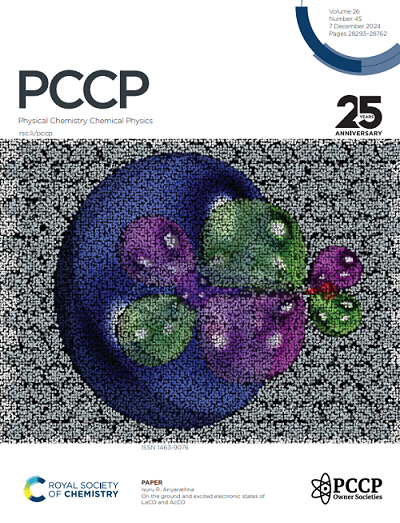Mechanisms and dynamics of halophilic reaction between CH2CN- and CCl4
IF 2.9
3区 化学
Q3 CHEMISTRY, PHYSICAL
引用次数: 0
Abstract
In gas phase experiments [J. Am. Soc. Mass Spectrom., 2005, 16, 2045], the reaction of the CH2CN- ion with CCl4 was observed to proceed predominantly via a halophilic reaction, where the nucleophile attacks a Cl atom, displacing the CCl3- ion, along with minor products from SN2 reactions and H/Cl exchange. In this study, the energetics of the three reaction pathways were investigated using DFT, MP2, and DLPNO-CCSD(T) methods. The B3LYP/6-311++G** level of theory accurately described the reaction pathways compared to the DLPNO-CCSD(T)/CBS benchmark while remaining computationally efficient. At the B3LYP/6-311++G** level, the halophilic pathway was found to be barrierless and energetically favorable, whereas the SN2 pathway exhibited an energy barrier of 4.34 kcal/mol relative to the reactants. The H/Cl exchange reaction is proposed to occur through sequential steps: an initial halophilic pathway followed by proton transfer, due to the high energy barrier of 11.71 kcal/mol for the direct reaction. The reaction dynamics, investigated through bimolecular ab initio trajectory simulations at the B3LYP/6-311++G** level, revealed the formation of major halophilic products, consistent with experimental findings. Additionally, the dynamics of the SN2 reaction were explored by analyzing the post-transition state trajectories.求助全文
约1分钟内获得全文
求助全文
来源期刊

Physical Chemistry Chemical Physics
化学-物理:原子、分子和化学物理
CiteScore
5.50
自引率
9.10%
发文量
2675
审稿时长
2.0 months
期刊介绍:
Physical Chemistry Chemical Physics (PCCP) is an international journal co-owned by 19 physical chemistry and physics societies from around the world. This journal publishes original, cutting-edge research in physical chemistry, chemical physics and biophysical chemistry. To be suitable for publication in PCCP, articles must include significant innovation and/or insight into physical chemistry; this is the most important criterion that reviewers and Editors will judge against when evaluating submissions.
The journal has a broad scope and welcomes contributions spanning experiment, theory, computation and data science. Topical coverage includes spectroscopy, dynamics, kinetics, statistical mechanics, thermodynamics, electrochemistry, catalysis, surface science, quantum mechanics, quantum computing and machine learning. Interdisciplinary research areas such as polymers and soft matter, materials, nanoscience, energy, surfaces/interfaces, and biophysical chemistry are welcomed if they demonstrate significant innovation and/or insight into physical chemistry. Joined experimental/theoretical studies are particularly appreciated when complementary and based on up-to-date approaches.
 求助内容:
求助内容: 应助结果提醒方式:
应助结果提醒方式:


